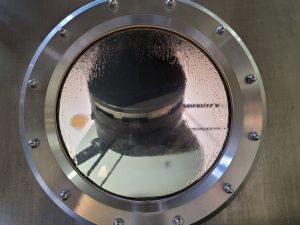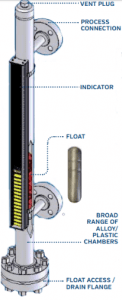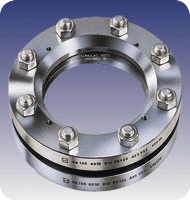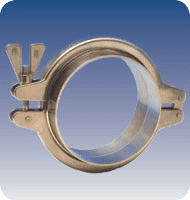ATEX and UL Certifications.
Manufacturers must meet a variety of standards to ensure the safety of their employees and their communities. In such industries as chemical and petrochemical, for example, vapors and mists escape during the production, processing, transportation and storage of flammable substances and during the production of mineral oil and natural gas. In such potentially explosive environments, it is critical to use certified equipment that can safely operate in these hazardous conditions.
A variety of certification standards regulate equipment used in explosive environments. Two of the most common sets of standards are ATEX and UL.
Process engineers typically question, when specifying equipment to be used in both Europe and the United States, what the ATEX and UL equivalencies are. In other words, if I specify something for ATEX Zone 1 or Zone 28, what is the corresponding UL Class and Division? The reverse applies as well for those specifying a UL level of performance. While this is a complex and technically precise question, we’ll address some general guidelines here.
ATEX Certification
The European Union [EU] has some of the world’s most stringent standards when it comes to safety. For example, the two ATEX (Atmospheric Explosives) directives, define strict guidelines for control and, more important, mitigation of explosive atmospheres within a given area. These guidelines apply not only to chemical plants but also oil and gas refineries, as well as other production and storage facilities. The regulations require companies to take steps to protect their employees, including installing appropriate safety equipment and making sure that employees are properly trained in how to handle these materials.
ATEX certification ensures that a company’s equipment meets international standards for safety and use in potentially explosive atmospheres. In this blog post, we will discuss why this certification is important and where it differs from UL certification, which has its own sets of standards.
ATEX Directive
The European Union’s ATEX directive applies everywhere there is a potential for an explosion from flammable gas, dust or vapor. The directive was created in response to the 2010 oil spill in the Gulf of Mexico. The explosion crippled Deepwater Horizon, a rig operating under lease to BP, and sent nearly 5 million barrels of oil into the water.
Since its creation, the ATEX directive has become the global standard for the use of equipment in explosive atmospheres, like those in the offshore oil and gas industry.
If your company works with hazardous materials, it’s crucial to make sure you are familiar with the ATEX directive. For more information on the ATEX directive, visit the European Union’s website at https://www.ecb.europa.eu/explainers/introducing-the-atex-directive/html/index.en.html.
ATEX is not just relevant to the industrial sector—it can also be applied in other places where an explosive atmosphere may be a risk. For example, gas stations, mines and even some domestic properties may have gas appliances that could cause an explosion if not installed and maintained correctly.
The directive applies to all types of electrical equipment, from simple household items to large plant machinery used in factories. The key thing to remember is that any item intended for use in an explosive atmosphere must comply with ATEX regulations. This includes both the equipment itself and the protective systems in place around it.
ATEX Zones
In order to categorize what type of environment electrical items may be used in, zone classifications are used. Zone 0 is a totally explosive atmosphere found in certain industrial plant operations. Zones 1 and 2 are more common; they classify areas where combustible gases, vapors and mists are present.
Zones 20 through 22 are classified for other explosive hazards such as dust and fibers.
How is ATEX Certification Achieved?
ATEX certification usually involves an impartial third-party organization that provides testing as part of the certification process. Certified equipment receives a “CE” marking to indicate compliance and an additional “Ex” marking to indicate official certification under the ATEX directive.
ATEX versus IECEx Certifications
IECEx stands for “International Electrotechnical Commission System for Certification to Standards Relating to Equipment for Use in Explosive Atmospheres.” IECEx certification, in contrast with ATEX, are intended to certify equipment or services for their use in global commerce, as it pertains to explosive environments. Although ATEX is derived from IECEx, it is designed to meet the specific requirements of the European Union.
UL Certification
UL Certification is a process that an electronic product goes through to ensure that it meets safety standards. The product is tested by an independent, third-party laboratory, Underwriter Laboratories, and, if it passes all of the safety tests, it is provided with a certification mark. These safety standards vary depending on the product category, but can include requirements for things like electrical safety, flammability and toxicity. Once the product has been UL tested, you can be certain that it has been manufactured and installed correctly to prevent malfunctions and product failures.
UL was founded in 1894 by William Henry Merrill, who had an interest in electrical fire safety. To test his theory about which materials were flammable in an electrical fire, he hung cloth sacks of various materials from the ceiling and set them on fire. The idea was to see which materials would burn the fastest and produce the most heat. From this experiment, Merrill developed a list of safety recommendations for manufacturers, including using noncombustible wiring insulation, that eventually became UL standards and were distributed to thousands of manufacturers.
UL standards cover everything from safety signs and emergency eyewash stations to laboratory fume hoods and fire protection systems and equipment. Over the years, UL has developed standards for more than 60 different product categories covering a wide range of products: appliances, electrical components, construction materials, personal care products and even toys.
What Does UL Mean for You?
So, what does UL certification mean for you as a business owner? It means that like the ATEX approval, you can trust that the equipment you are purchasing and installing is safe for your employees and customers because it has been tested and certified to meet UL safety standards.
Why Is UL Certification important?
UL Certification is important for a number of reasons, but mainly because it ensures the safety of your employees and customers. By installing UL certified products in your business, you can be sure that these products have been tested and meet the safety standards set by UL. This helps avoid malfunctions and employee injuries. UL certification is important because it lets you know that:
- The product has been tested to ensure it is safe for employees and customers.
- The product has been tested for defects.
- You are following best practices and setting a standard for protecting your employees and customers.
How to Tell Whether a Product Is UL Certified
UL certification is indicated by a UL mark on the product. This mark is a sign that the product has been tested and certified by UL and meets all the safety standards set by UL.
You can search for UL certified products and equipment at www.UL.com. Here, you will be able to browse through a broad range of different certifications and categories that feature UL certified products and equipment. You can also learn about UL standards for all industries, explore UL services and access UL resources to learn more about UL certifications and requirements.
ATEX and UL Equivalence
There is no one-to-one equivalent between ATEX and UL specs, as they are two different safety certification systems. However, both systems are designed to ensure that equipment is safe for use in potentially explosive environments.
ATEX is governed by the European Union, and any equipment used for ATEX purposes must be CE marked. UL is a private company, and it does not issue certificates on its own; rather, it has contracts with companies around the world to perform certification inspections. It also maintains lists of safety-certified products, which do not have to be UL-certified, but they must conform with the UL’s safety standard.
For example, ATEX Zone 0 is classified as an explosive gas atmosphere (e.g., natural gas), and Zone 1 is an explosive dust atmosphere. By comparison, UL 60950 covers Class I, II and III locations, which are defined as follows:
- Class I: Locations with a flammable gas or vapor present in the air in quantities that could cause a fire or explosion.
- Class II: Locations with combustible dust present in the air in quantities that could cause a fire or explosion.
- Class III: Locations with surfaces at distances from sources of ignition where, if an ignition should occur, the heat released by the flame would not be sufficient to ignite cotton waste or paper one foot away.
ATEX Zones versus UL Classes, Divisions and Groups
The central question you may be asking yourself is this: If I specify something for ATEX, what is the UL equivalent–or vice versa?
Although, as stated above, there are no exact one-to-one equivalents, in general: UL Zones 1 through 4 correspond to ATEX Areas 1 through 2; UL Area 0 corresponds to ATEX Zone 0; and UL non-classified areas correspond to ATEX Zone 20.
In more detail:
- ATEX Zone 10 is equivalent to UL Class I, Division 2 Groups A, B, C and D. ATEX Zone 20 is equivalent to UL Class II, Division 1 Groups E, F and G.
- ATEX Zone 21 is equivalent to UL Class III, Division 1. ATEX Zone 22 is equivalent to UL Class III, Division 2.
- ATEX Zone 23 is equivalent to UL Class I, Division 1 Groups A, B, C and D. ATEX Zone 24 is equivalent to UL Class II, Division 2 Groups E, F and G.
- ATEX Zone 25 is equivalent to UL Class III, Division 2.
- ATEX Zone 26 is equivalent to UL Class I, Division 2 Groups A, B, C and D. ATEX Zone 27 is equivalent to UL Class II, Division 1 Group E.
- ATEX Zone 28 is equivalent to UL Class III, Division 1.
- ATEX Zone 29 is equivalent to UL Class I, Division 1 Groups A, B, C and D. ATEX Zone 30 is equivalent to UL Class II, Division 2 Group E.
- ATEX Zone 31 is equivalent to UL Class III, Division 2.
- ATEX Zone 32 is equivalent to UL Class I, Division 2 Group A. ATEX Zone 33 is equivalent to UL Class II, Division 1 Group B.
- ATEX Zone 34 is equivalent to UL Class III, Division 1.
- ATEX Zone 35 is equivalent to UL Class I, Division 2 Groups A, B, C and D. ATEX Zone 36 is equivalent to UL Class II, Division 2 Group F.
- ATEX Zone 37 is equivalent to UL Class III, Division 2.
Keep in mind, however, that some UL Zones have multiple numbers as their designation, and they correspond to the same area as a single number in ATEX, and vice-versa. A common example of this would be non-classified areas for both UL and ATEX: it is not uncommon for UL to designate a non-classified area as Zone 1 or some other letter, but ATEX to call it 20.
Remember, UL Area 0 and ATEX Zone 0 are not equivalent, even though some equipment may be able to be used in both. In fact, to legally sell equipment for use in ATEX Zone 0, it must be ATEX-certified, as well as UL listed.
It’s important for companies to coordinate their marketing communications with UL, ATEX and other product safety-related organizations, in addition to standardizing the way they refer to IEC Ex products, in order to ensure compliance with all applicable standards.
Contact LJ Star for More Information
For more information about ATEX, UL and other certifications, specifically as they pertain to process observation equipment, please contact LJ Star, and we will be happy to answer your questions.
LJ Star is a key partner and supplier to the pharmaceutical, biotech, medical marijuana, food, dairy and the oil and gas industries.




